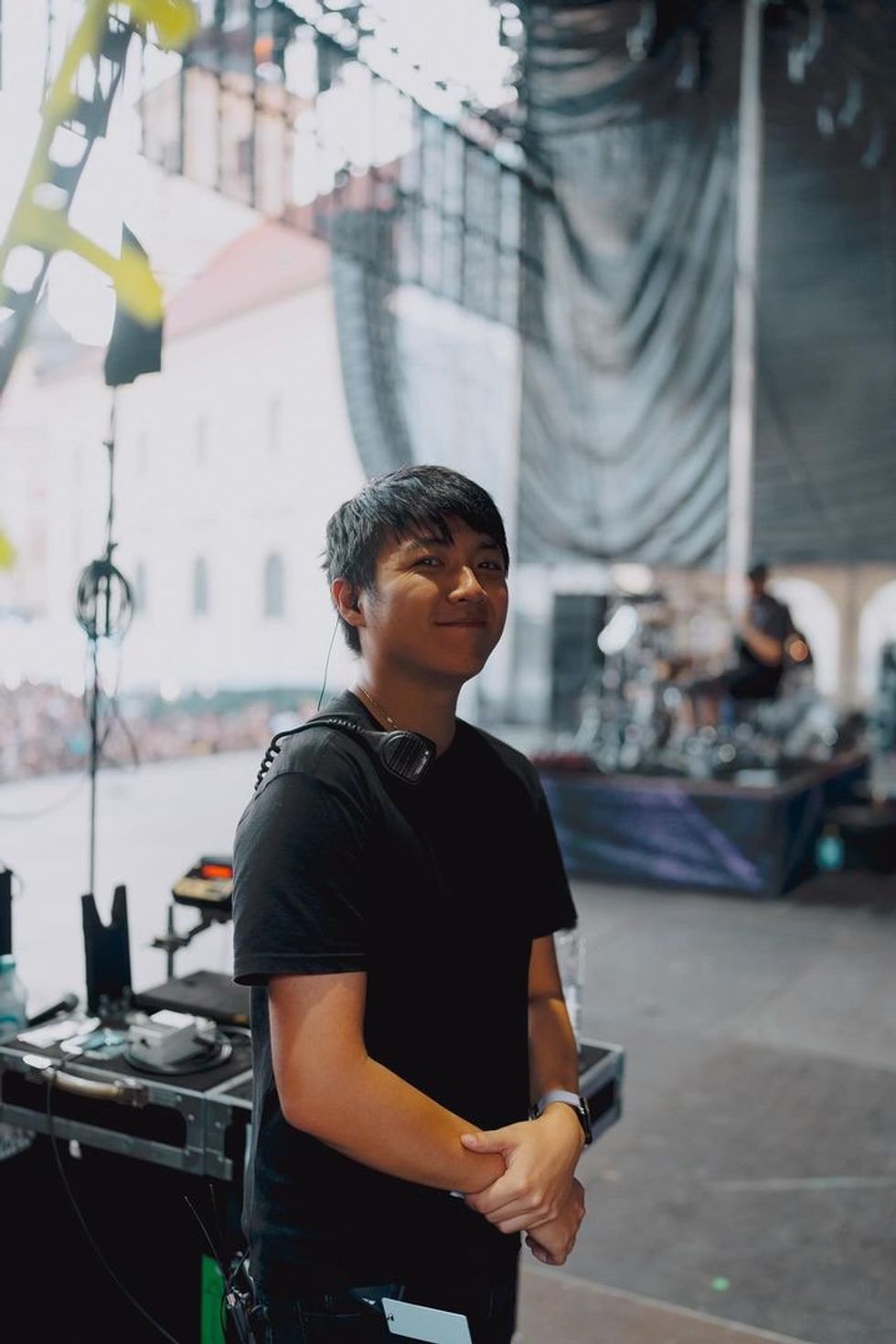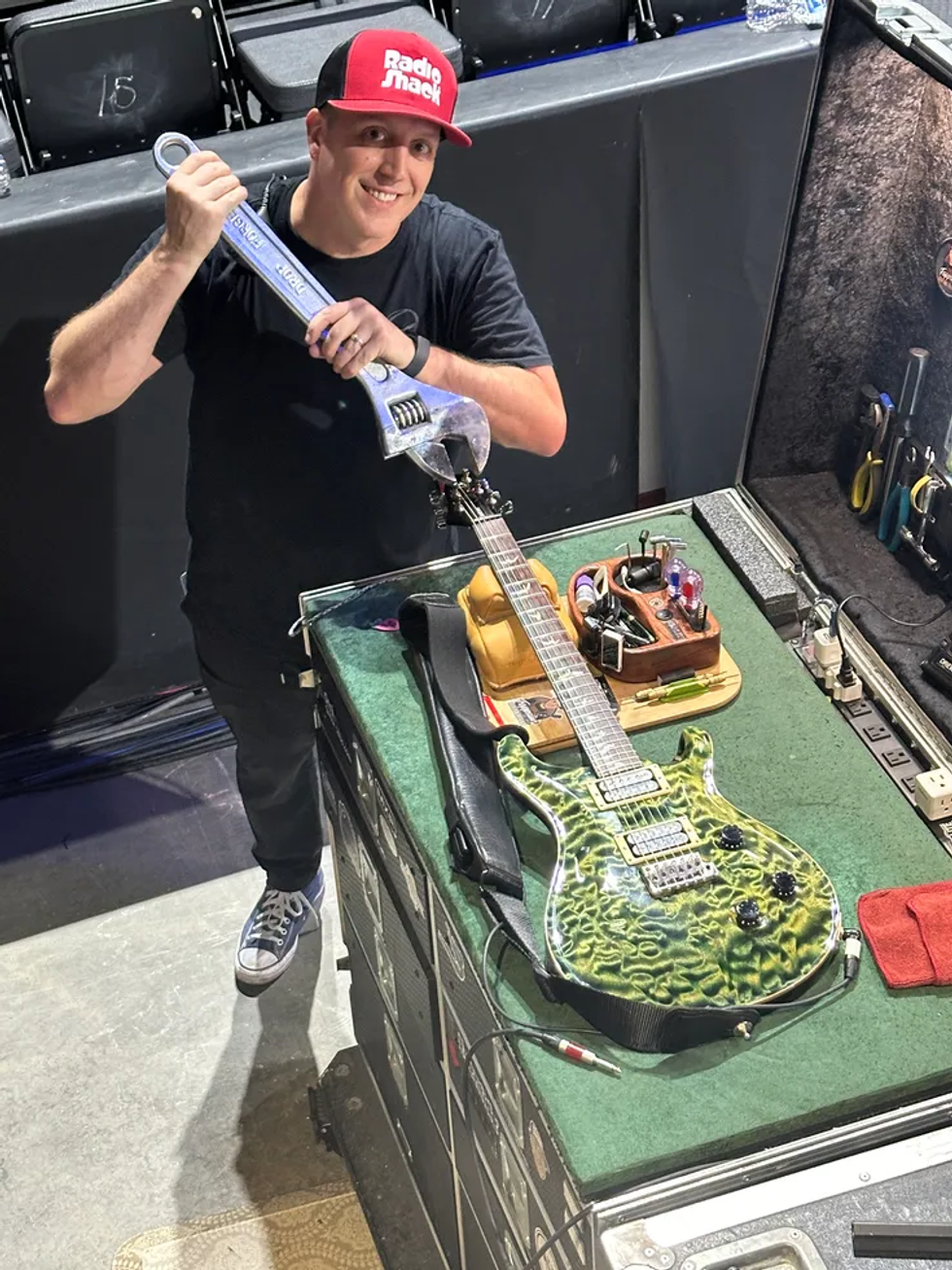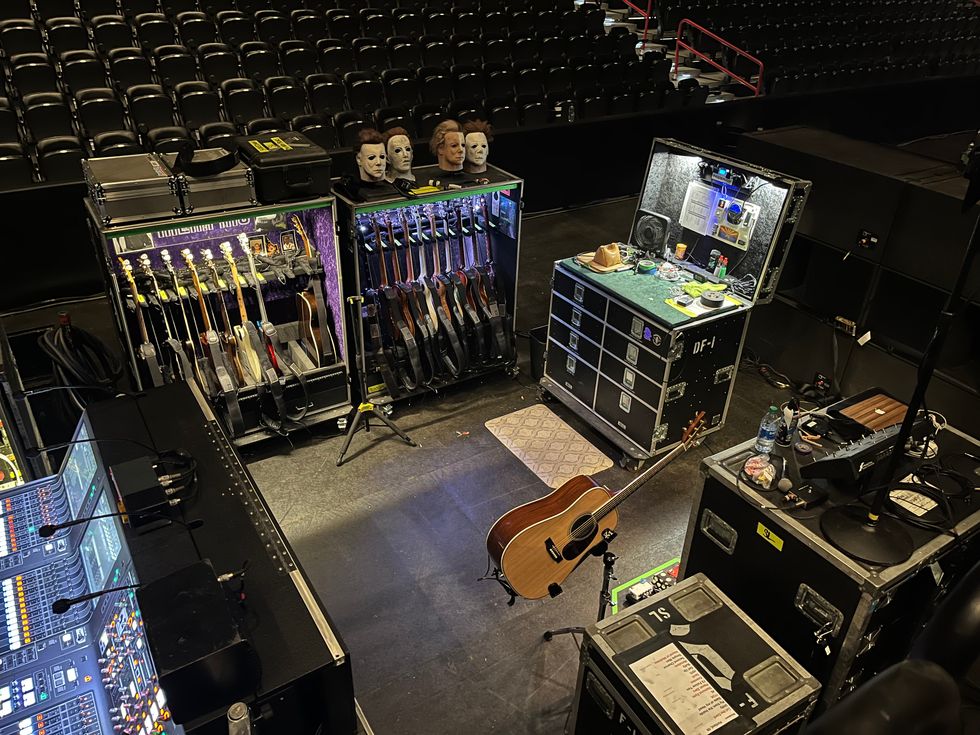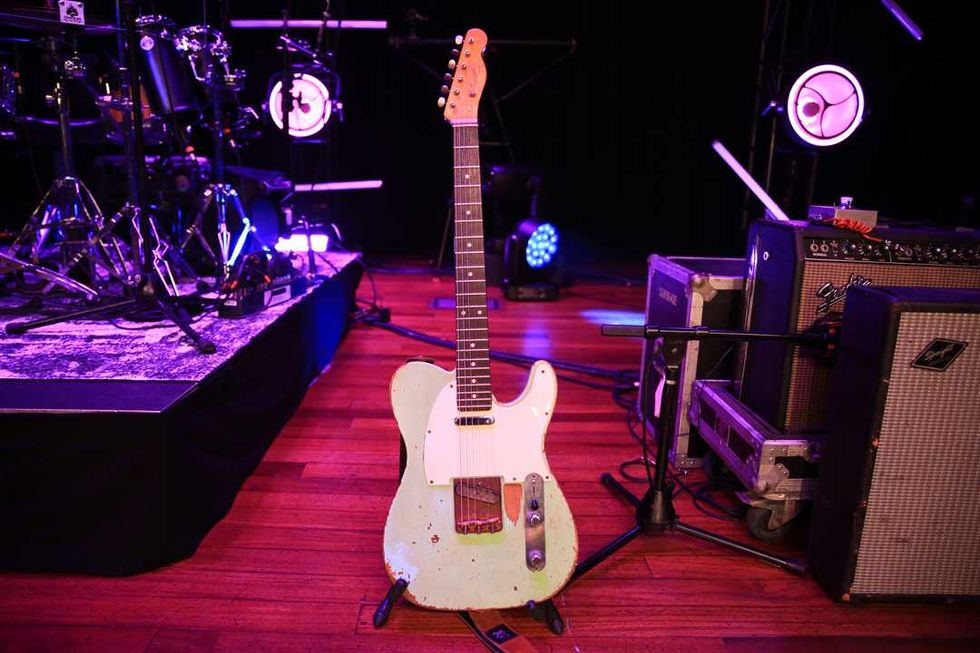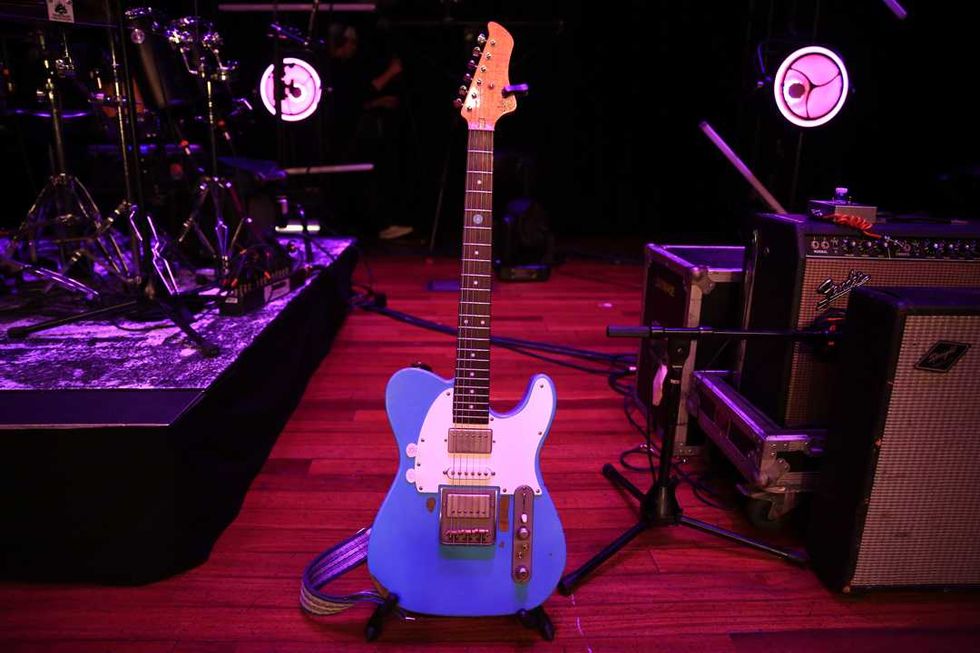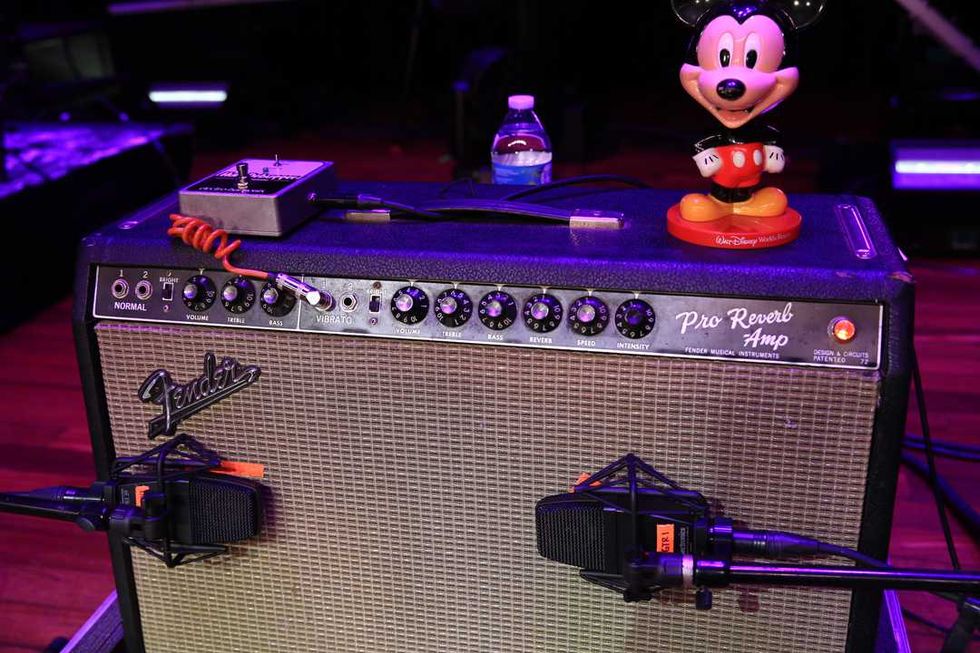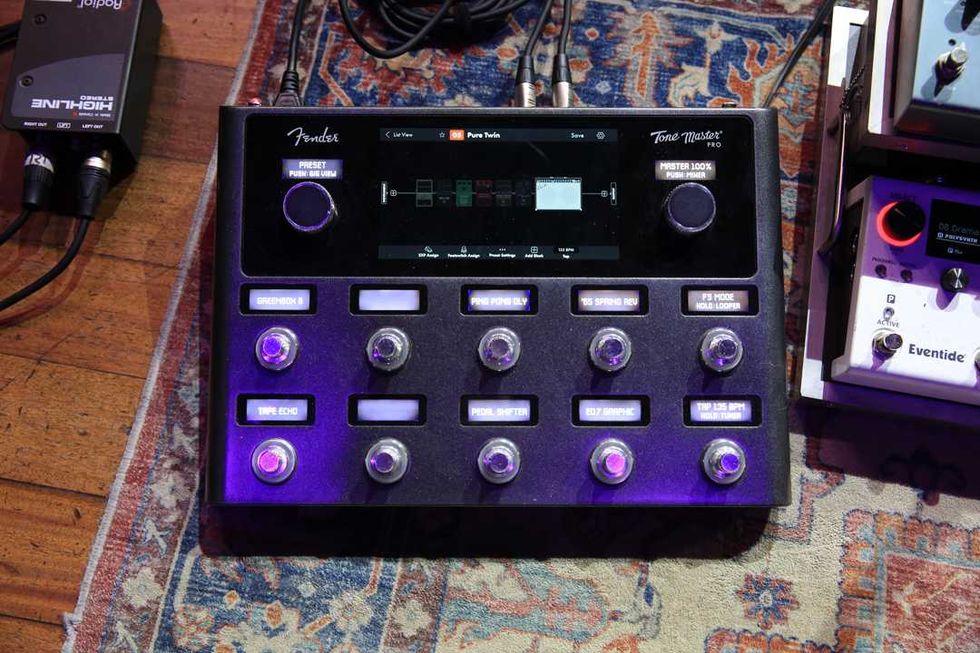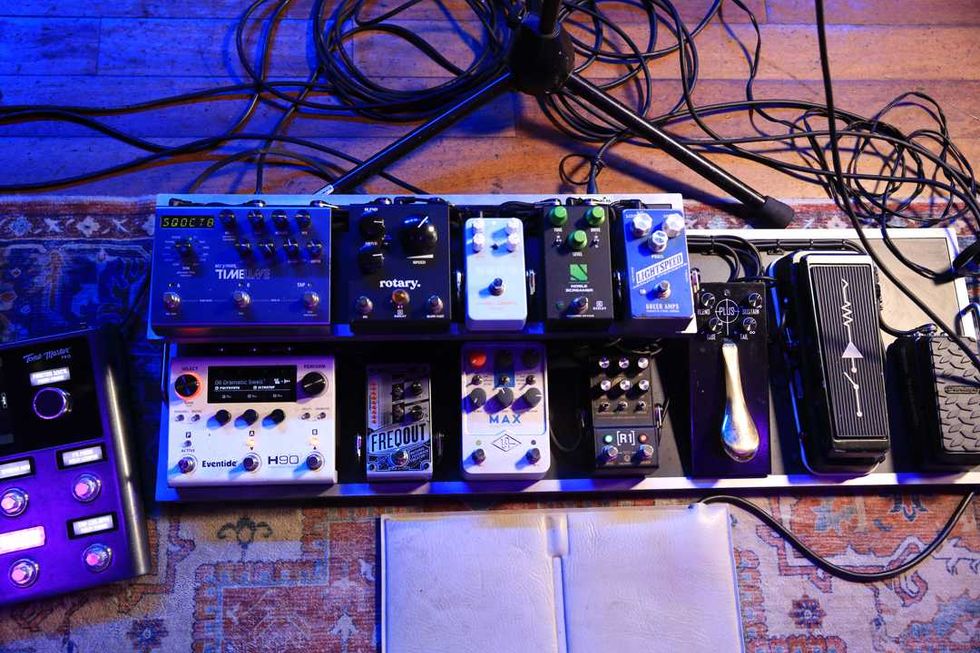Steven Wilson’s new release Hand. Cannot. Erase. draws inspiration from the story of Joyce Carol Vincent, a woman found dead in her London flat, undiscovered for nearly three years. But the album doesn’t merely retell this ghastly tale. “I didn’t want to just write a story about a woman who dies in her apartment—that would be a bit depressing,” says Wilson. “But I liked the idea of writing a story about isolation in the city and how technology affects our sense of isolation in the 21st century.”
Hand. Cannot. Erase. is the fourth solo project for the busy Wilson, who also fronts the iconic prog-rock band Porcupine Tree and performs with or produces artists ranging from Yoko Ono to Opeth. The new album reunites the all-star lineup that brought Wilson’s epic musical visions to life on 2013’s The Raven That Refused to Sing (And Other Stories): guitar phenom Guthrie Govan, drum god Marco Minnemann, onetime Miles Davis keyboardist Adam Holzman, and bassist Nick Beggs. Another facet of the project is the blog handcannoterase.com, which features cryptic entries from the point of view of Wilson’s isolated protagonist.
Wilson insists he’s no fan of shred guitar, yet no one embodies modern-day shred more than Govan. We queried both master musicians about their unlikely collaboration.
Steven Wilson: Two-Sided Stories
What fascinated you about the Joyce Carol Vincent story?
Steven Wilson: The story is extraordinary enough in itself, but when I found out more background, it became even more extraordinary. This was not a lonely old lady—she was a young, attractive woman with friends and family. I created a character that gave me the opportunity to explore the subject of 21st-century isolation. What it means to be living in the heart of the city, and how easy it is to become invisible in that context.
Did you have the storyline in place from the beginning?
No. Things edged each other on gradually. I wrote a few phrases and had a couple of titles, and then I wrote a bit more lyrics, and then a bit more music. It’s easy to write pages and pages of prose and lyrics, and then try to shoehorn them into music. But I like to feel that the mood of the music is affected by the lyrics, and the lyrics are affected by the music. I don’t really have a master plan. All I know is that you have all these jigsaw puzzle pieces, and you have to put them together in a way that makes sense. I don’t think it’s any different from what a novelist goes through, or someone who creates a movie. Never underestimate the amount of work that goes into creating a great film script or a novel!
Other themes come into play as the record progresses.
Yes. Things like relationships and nostalgia for childhood. A lot of it is also autobiographical. The album has some joyful elements too. It’s the story of someone’s whole life, so it goes through all of the contours that we go through in our lives.
The handcannoterase.com site seems to be ongoing. When does it end?
Who can say? I can’t say.
Are you posting the blog entries yourself?
The character is putting the entries up.
Is everything already mapped out, or is the story unfolding in real time?
I have a story in mind, but the story can surprise me. The story is still evolving even as the album is finished.
What does the album title mean?
I’m not going to tell you what the title means, but I’ll tell you why I’m not going to tell you: When you give an album a title, you’re almost telling the listener what the album is about. I could have very easily called it The Loneliness of Living in the City, because it is about that. But of course, it’s also about other things: nostalgia, childhood, family, the internet, the city, modern life, paranoia, confusion, technology. So the answer to the conundrum is to pick a title with a sense of mystery that allows the audience to interpret it for themselves.
You brought back the lineup from The Raven That Refused to Sing. Did you write with them in mind, or independently of a specific lineup?
A bit of both, because there’s no guarantee I can get the musicians I would like to get. Guthrie, Marco, Adam, and Nick are very much in demand as players. But I’m aware of what they’re capable of, and that if I’m writing for musicians of that caliber, I can write stuff that I myself could never play. When I’m in a band, I’m writing guitar parts for myself, and I have to be able to play them. When I work with a player like Guthrie, there are no limitations. He can play anything.
Did you give him direction?
His solos are his solos, and they are improvised. To be honest, the usual direction I give to Guthrie is, “Can you play slower?” I don’t really like shredding, and he knows that I don’t. His natural inclination is to play quite fast.
Steven Wilson's Gear
Guitars
PRS Custom 22
Babicz acoustic
Ovation Elite acoustic (Nashville tuning)
Custom Alumisonic 1100
Spector Coda 5-string bass
Amps
Bad Cat Lynx 50 head with Bad Cat 4x12 cabinet
Effects
Electro-Harmonix Micro POG
Diamond Vibrato
Moog MF Trem
J. Rockett 10 Ton Hammer distortion
Analog Man Prince of Tone
Dinosaural Opticompressor
TC Electronic PolyTune
Strymon BigSky Reverb
Strymon TimeLine Delay
Option 5 Destination Rotation Single
TheGigRig G2 bank switch
TC Electronic Ditto Looper
Source Audio Programmable EQ
Boss FV-500H volume pedal
Dunlop Cry Baby Wah
Strings and Picks
D’Addario strings, .010–.048 (.010–.054 for dropped-D tuning)
D’Addario custom picks
Someone who isn’t aware of the broader scope of Guthrie’s abilities might ask why you chose him if you’re not a shred fan.
Because when he plays slowly, he’s incredible. He can play slow or fast and blow you away. The speed he plays is irrelevant—what is important is the creativity and the character of the way he plays. I had him do stuff on this record that he probably wouldn’t normally do, but he instantly picked it up and did it incredibly.
I imagine this project isn’t so much a democracy as you hiring the best possible band to bring your musical vision to life. Yeah, pretty much. That’s been the great gift of my solo career: being able to work with these incredible musicians and put myself in more of a director role. I don’t even have to play on these songs, because I have these incredible musicians. In a way, that was what I always wanted to be. I grew up listening to people like Frank Zappa and imagining myself in the auteur role, being able to hire incredible musicians and come up with material for them to play. I’m very fortunate to get myself into that position.
I saw a video of you once playing a chord shape that you couldn’t describe in technical terms. How do you communicate those types of harmonic structures to the musicians? I imagine they’re used to working with scores or charts.
I show them. Guthrie will say, “Ah, you’re playing E minor diminished nine,” and I’m like, “Whatever.” [Laughs.] I do demos that are quite advanced. They flesh out the whole arrangement so the musicians know what they’re supposed to do.They give the exact structure. These are things I toil over for weeks on end: The correct structure. The right way for the story to unfold. The right way for the music to take you on the right kind of musical journey.
Did you track the parts live?
I tried to do as much as possible the old-fashioned way, with four or five musicians looking at each other across the room.
Let’s talk gear. I know you’ve used your PRS guitars for over a decade, but you recently unveiled a new pedalboard on your Facebook page.
I just moved to a new GigRig board, which is all pedals—I’ve gotten rid of any multi-effects. Daniel [Steinhardt, GigRig’s founder] put together a whole new pedalboard for me, and I haven’t even taken it on tour yet. You’ll have to forgive me, because I can’t remember everything in there, but I know I’ve got a Strymon reverb and a Strymon delay, with the presets being switched by MIDI triggers. Basically, I said to Daniel, “Get me the best of everything—the best delay, the best reverb, the best distortion,” and he put it together for me.
Your music tends to be dark, though your personality doesn’t seem especially so. Why do you gravitate toward darker moods in your music? I think you’ve answered your own question. Making music that’s a little bit melancholic is a way to exorcise that part of my personality so I can be a happier person. We all have a dark side and a positive side, and everyone finds their own way to deal with the darker energy. For some people it might be playing squash or football, or whatever. For some people it’s making music. There’s no question that music and writing are cathartic for me. In a way, to see the full me, you need to meet me as a person and see me in connection with the music I make and the work I create because they are very much the two sides of my psyche.
Guthrie Govan’s signature Charvel guitars feature over-baked necks and bodies, which Govan says improves their stability and acoustic resonance. Photo by Kris Claerhout
Guthrie Govan: Playing for Steven’s Songs
Steven says he’s not a fan of shred guitar, yet no one embodies state-of-the-art shredding more than you.
Guthrie Govan: I guess we have slightly different personalities. I’m a skinny, twitchy, coffee-drinking character, and the music I hear in my head sometimes has more notes than other people enjoy. I’m happy to try and do whatever works best for the song, really.
What’s it like for a renowned virtuoso like you to be working in a sideman capacity? I couldn’t do it all the time. If I were strictly a sideman, I’d be tearing up the furniture. But it’s nice to be part of Steven’s band because he has such a clear vision of what he wants the music to sound like, and he approaches everything with professionalism, so I know I’m involved with something that’s going to sound good.
You’re doing the European leg of the Steven Wilson tour, and then taking off to do an Aristocrats tour this summer. Who will fill in for the Wilson gig? We’ve got David Kilminster coming in. He’s done the Roger Waters show for the last eight years. This was partly my suggestion. He’s been a friend of mine for more than 20 years, and we’ve played together in all sorts of situations. I’m completely relaxed about handing the gig over to someone that both Steven and I can trust.
Filling in for Guthrie Govan would be daunting for many guitarists. Is there any situation that would intimidate you? No, because music isn’t a contest. I know there was a grandstanding, showboating aspect to ’80s rock. The guitar player was very much the gunslinger, and you had to have a bigger weapon than the other players, and all that kind of nonsense. That’s never really been a prime motivation for me. If somebody trusts me enough to invite me to play guitar on their project, I’d go in and do my best, and not worry about counterproductive stuff.
You’ve done a lot of clinics. Don’t you see that competitive attitude among the guitarists who attend? Some of them, but it used to be more that way. When I was just a guy sent there by a company to do a clinic, people would sit there with their arms folded and say, “Come on man, do your tricks. Do something I couldn’t do,” and then wait for me to screw up. But now I seem to have a higher profile, so the people at the clinics generally have more of an idea of where I’m coming from. They come to see me and check out what I have to say, and they have some idea that I’ll talk about things like “Why do we play music?” and “How do you improvise?” It’s pretty rare that I get anyone at a clinic challenging me to do an Olympic feat, and this pleases me.
A couple of years ago you told us that your first Charvel prototype was made from koa [Steve Wilson and Guthrie Govan Rig Rundown, March 2013]. But you then switched to basswood on the back and bird’s-eye maple on the top. The production guitar is basswood. I still have the koa prototype, which sounds great for certain things. To my ears, koa sounds as if you’d recorded a mahogany guitar and sped it up slightly. It has a honky, midrange-y bark that’s a little higher up in the frequency spectrum. It’s a great-sounding wood, but anytime I have to take one guitar and produce a number of different sounds, I trust the combination of basswood with a maple top more than anything else because it seems to bring out every frequency equally. It doesn’t favor any particular tonality, so you’ve got a neutral starting point that you can sculpt with pick dynamics, pedals, and amps, as the situation requires.
Guthrie Govan's Gear
Guitars
Charvel Guthrie Govan signature model
Fender American Deluxe Strat
Gibson ES-335
Amps
Victory V100 head though Victory 4x12 cab with Celestion Vintage 30 speakers
Effects
Suhr Koko Boost
Strymon Flint
Electro-Harmonix Micro Synth
Strings and Picks
Rotosound Roto Yellows strings, .010–.046
Red Bear Signature picks (extra-heavy)
Do your guitars use baked woods? Yeah. The necks are baked on all my current Charvels. They resonate slightly differently, and the acoustic tone is a little more alive. It’s also extra stable, which is good news for anyone who’s on the road a lot. I took it to Indonesia, and I guess it’s immune to humid climates. Just to show you how obsessed with the whole baking thing we are, they also bake the basswood bodies on the production Charvels. They had to be a little more careful because it’s a softer, spongier wood than maple, but they found a way of doing it.
What other guitars did you use on Hand. Cannot. Erase.? I borrowed an American Deluxe Strat from Fender. It has noiseless pickups and sounded really good to my ears. You can use them with a more overdriven tone than you perhaps could with vintage-style Strat pickups. The buzz doesn’t kick in, because there isn’t any buzz. I used it on the long solo in “Regret #9.” I also used my Gibson ES-335 on “Ancestral.” I picked it up 10 years ago because I discovered that it was the same age as me. I thought that was cool, and I bonded with it at the shop.
What amps did you use?
For the sessions, I used a Victory V100 with a 4x12 cab with Celestion Vintage 30 speakers. Victory is a relatively new U.K. company. The guy who designs their amps [Martin Kidd] previously designed amps for Cornford.
What about the Axe-Fx? If I’m at home at four in the morning and need to record a guest solo, it’s fantastic for that. But if I have the luxury of going to a proper studio and miking up a real cab, I just feel more comfortable that way. If you’re at AIR Studios [where Hand. Cannot. Erase. was recorded], you might as well bring a real amplifier. The Axe-Fx reproduces the sound of a recording of an amp, which is different from reproducing the amp itself. It’s great for what it does, but there are certain musical scenarios where I just feel more at home using an old-school solution.
How did Steven present the music to you? Steven gives us demos of such quality that normal people would just release them as a finished album.
How long did it take for you to prepare? It seems like a lot of music to learn without charts. I wasn’t really counting the hours. The way I normally handle it is to visit Steven’s music here and there, rather than trying to cram it too much. I don’t think there’s anything hugely complex or difficult on those albums. Basically, I need a rough outline of the big picture. I’ve been going to his house once per album cycle to listen to his demos, and he describes roughly what he has in mind for certain sections.
Do you interact differently with drummer Marco Minnemann in Steven Wilson’s project than when playing together in your band, the Aristocrats? It’s a completely different band and a completely different dynamic. To a much greater extent, what Marco and I do in Steven’s band is scripted. There’s less scope for naughtiness. With the Aristocrats we prepare a lot less for an album or a show, but communicate a lot more. Marco and I have a natural connection. We understand each other musically. With Steven’s band, we play to a click track live, and each of us is a smaller part of a bigger band. So we inevitably interact in a different way.
What about effects? I made a big pedalboard especially for the Steven tour. Normally I travel very light. I don’t use a wah for any of the Steven stuff. There’s the Suhr Koko Boost, and there’s at least one track with the Strymon Flint for a tremolo sound. I’m probably using some reverb from the Strymon as well. My Steven pedalboard weighs more than I do, but that’s not much of an achievement, given my meager frame. It’s more than I can justify shipping around the world for any other kind of tour. If I’m living in a bus, the pedalboard can go in a trailer behind the bus. If there’s a burly man available to lift it from A to B, I might as well have some fun.
What about the Providence Anadime Chorus that you use with the Aristocrats? Chorus pedals are officially banned. Steven hates them, so fair enough—that’s part of his musical vision. He does have this concept of a guitar sound that he calls “wibble,” which means anything that’s modulating somehow but isn’t a chorus. We also had a real Leslie in the studio. There was one solo on “Three Years Older” where we plugged into an Electro-Harmonix Micro Synth. I was playing the notes, and Steven was furiously moving the sliders.
Did you encounter any tracking glitches? As long as you’re being monophonic, it understands. There’s no MIDI going on—it’s not like it needs a hex pickup. It just analyzes the audio you feed into it and mutilates it in a pleasing way.
Are you using the Victory amp’s overdrive? Yeah. The only thing you’ll hear is the Koko Boost pushing a little extra mids into the amp for some of the solo stuff. I’ve always been more of an amp guy than an overdrive pedal guy.
YouTube It
This live rendition of “The Holy Drinker” from Frankfurt, Germany, starts off with harmonically intriguing prog-fusion solos before vocals enter around 2:39.


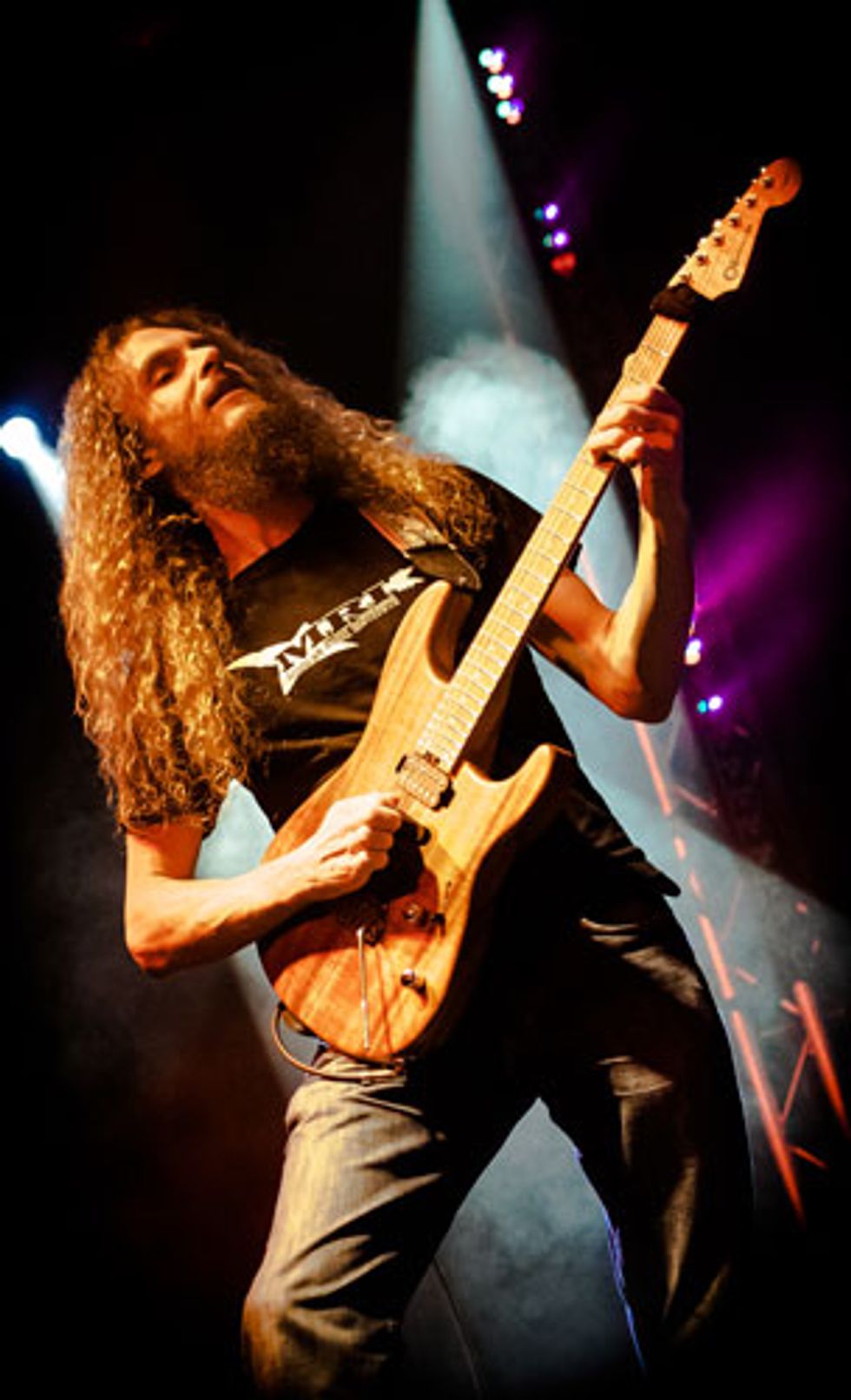




![Rig Rundown: AFI [2025]](https://www.premierguitar.com/media-library/youtube.jpg?id=62064741&width=1245&height=700&quality=70&coordinates=0%2C0%2C0%2C0)












 Shop Scott's Rig
Shop Scott's Rig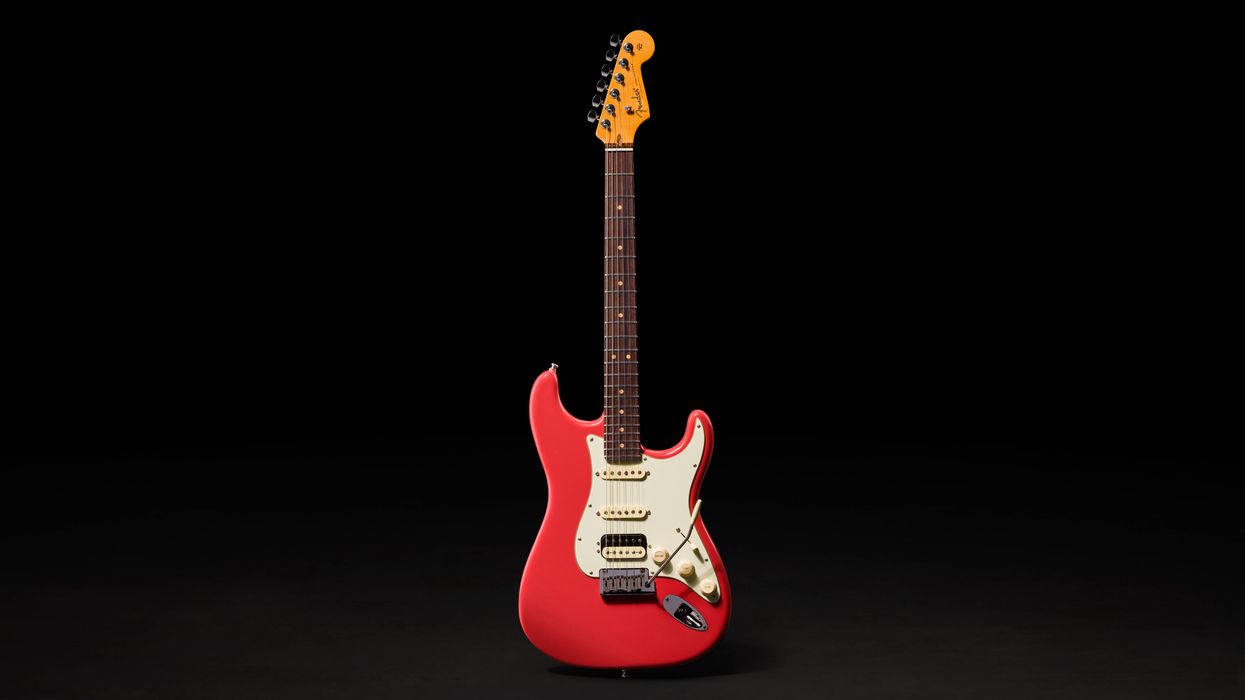
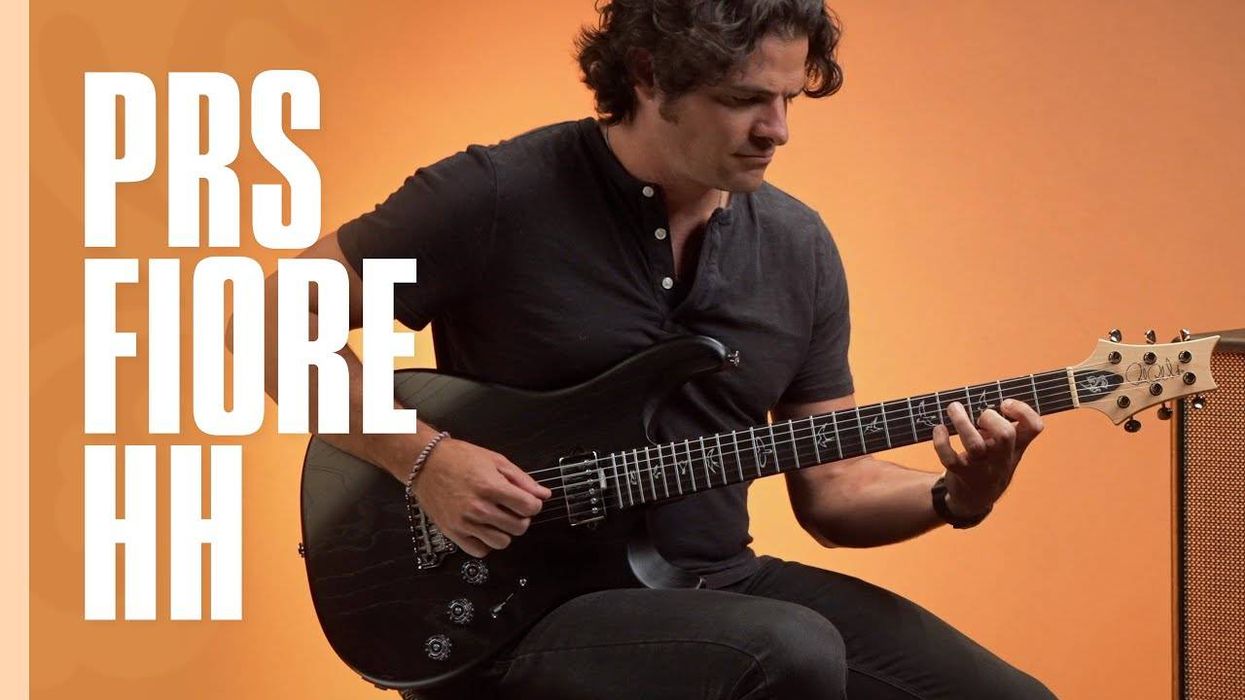

![Devon Eisenbarger [Katy Perry] Rig Rundown](https://www.premierguitar.com/media-library/youtube.jpg?id=61774583&width=1245&height=700&quality=70&coordinates=0%2C0%2C0%2C0)










 Zach loves his Sovtek Mig 60 head, which he plays through a cab he built himself at a pipe-organ shop in Denver. Every glue joint is lined with thin leather for maximum air tightness, and it’s stocked with Celestion G12M Greenback speakers.
Zach loves his Sovtek Mig 60 head, which he plays through a cab he built himself at a pipe-organ shop in Denver. Every glue joint is lined with thin leather for maximum air tightness, and it’s stocked with Celestion G12M Greenback speakers.













 Luis Munoz makes the catch.
Luis Munoz makes the catch.